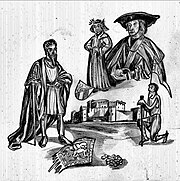Leonhard of Gorizia
Leonhard | |
|---|---|
Garay |
Leonhard (1440 – 12 April 1500) was the last
Family
Leonhard was born at
Leonhard married, in 1478, Paola
During the negotiations for his marriage, Andrea da Schivenoglia, chronicler of the Gonzaga family, described the then 36-old Count of Gorizia as "pleasant and joyful" (piaxevolo et zoioso).[1]
Early reign
Leonhard at first ruled jointly with his brothers John II and Louis. John as the eldest apparently held most of the power while younger Louis did not exercise any political role and died between 1456 and 1457. The brothers had to face the hostility of Emperor Frederick III who aimed to seize their remaining "outer county" around the town of Lienz and the Puster Valley, separating the Habsburg hereditary lands of Tyrol and Carinthia, which had been possessions of the Meinhardiner dynasty until the 14th century.
Moreover, John and Leonhard picked a fierce inheritance conflict around the lands of the extinct
Succession

Facing the extinction of the dynasty, sickly Count Leonhard became subject to the competing pressures of both the Imperial Habsburg dynasty and the Republic of Venice, which both competed for his heritage. The Venice Ten, who since 1434 ruled over the Domini di Terraferma in Friuli, intended to seize the adjacent "inner county" centered on the town of Gorizia itself.
During his reign his administrator Virgil von Graben was persuaded by grand promises by King
Upon his death,
References
- ^ "Treccani - la cultura italiana | Treccani, il portale del sapere".
- ^ wayback=20140113124200 Hermann Wiesflecker: Österreich im Zeitalter Maximilians I.: die Vereinigung der Länder zum ...
- ^ Mitteilungen des Instituts für Österreichische Geschichtsforschung, Band 56
- ^ Mitteilungen des Instituts für Österreichische Geschichtsforschung, Band 56
- ^ Mitteilungen des Instituts für Österreichische Geschichtsforschung, Band 56
- ^ Hermann Wiesflecker: Die Grafschaft Görz und die Herrschaft Lienz, ihre Entwicklung und ihr Erbfall an Österreich (1500). In: Veröffentlichungen des Tiroler Landesmuseum Ferdinandeum. Band 78, Innsbruck 1998, p 142, 144 (VeroeffFerd_78_0131-0149.pdf).
